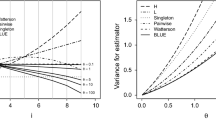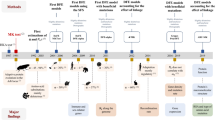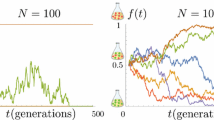Abstract
The nearly neutral theory attributes most nucleotide substitution and polymorphism to genetic drift acting on weakly selected mutants, and assumes that the selection coefficients for these mutants are drawn from a continuous distribution. This means that parameter estimation can require numerical integration, and this can be computationally costly and inaccurate. Furthermore, the leading parameter dependencies of important quantities can be unclear, making results difficult to understand. For some commonly used distributions of mutant effects, we show how these problems can be avoided by writing equations in terms of special functions. Series expansion then allows for their rapid calculation and, also, illuminates leading parameter dependencies. For example, we show that if mutants are gamma distributed, the neutrality index is largely independent of the effective population size. However, we also show that such results are not robust to misspecification of the functional form of distribution. Some implications of these findings are then discussed.


Similar content being viewed by others
References
Abramowitz M, Stegun I (1965) Handbook of mathematical functions. Dover, New York
Bulmer M (1991) The selection-mutation-drift theory of synonymous codon usage. Genetics 129:897–907
Bustamante CD, Nielsen R, Sawyer SA, Olsen KM, Purugganan MD, Hartl DL (2002) The cost of inbreeding in Arabidopsis. Nature 416:531–534
Charlesworth J, Eyre-Walker A (2007) The other side of the neutral theory, evidence of slightly advantageous back-mutations. Proc Natl Acad Sci USA 104:16992–16997
Davies EK, Peters AD, Keightley PD (1999) High frequency of cryptic deleterious mutations in Caenorhabditis elegans. Science 285:1745–1747
Elena SF, Ekunwe L, Hajela N, Oden SA, Lenski RE (1998) Distribution of fitness effects caused by random insertion mutations in Escherichia coli. Genetica 102(103):349–358
Ewens WJ (1979) Mathematical population genetics. Springer, Berlin
Eyre-Walker A (2002) Changing effective population size and the McDonald Kreitman test. Genetics 162:2017–2024
Eyre-Walker A (2006) The genomic rate of adaptive evolution. Trends Ecol Evol 21:569–575
Eyre-Walker A, Keightley PD (2007) The distribution of fitness effects of new mutations. Nat Rev Genet 8:610–618
Eyre-Walker A, Keightley PD, Smith NGC, Gaffney D (2002) Quantifying the slightly deleterious mutation model of molecular evolution. Mol Biol Evol 19:2142–2149
Eyre-Walker A, Woolfit M, Phelps T (2006) The distribution of fitness effects of new deleterious amino acid mutations in humans. Genetics 173:891–900
Fine NJ (1951) Note on the Hurwitz zeta-function. Proc Am Math Soc 2:361–364
Galassi M, Davies J, Theiler J, Gough B, Jungman G, Booth M, Rossi F (2006) GNU scientific library reference manual—revised second edition (v1.8). Network Theory, Bristol
Gillespie JH (1991) The causes of molecular evolution. Oxford University Press, Oxford
Gillespie JH (1995) On Ohta’s hypothesis: most amino acid substitutions are deleterious. J Mol Evol 40:64–69
Gillespie JH (2001) Is the population size of a species relevant to its evolution? Evolution 55:2161–2169
Gu X (2007a) Stabilizing selection of protein function and distribution of selection coefficients among sites. Genetica 130:93–97
Gu X (2007b) Evolutionary framework for protein sequence evolution and gene pleiotropy. Genetics 175:1813–1822
Hartl DL, Moriyama EN, Sawyer SA (1994) Selection intensity for codon bias. Genetics 138:227–234
Keightley PD (1994) The distribution of mutation effects on viability in Drosophila melanogaster. Genetics 138:1315–1322
Keightley PD, Eyre-Walker A (1999) Terumi Mukai and the riddle of deleterious mutation rates. Genetics 153:515–523
Kimura M (1962) On the probability of fixation of mutant genes in a population. Genetics 47:713–719
Kimura M (1969) The number of heterozygous nucleotide sites maintained in a finite population due to steady flux of mutations. Genetics 61:893–903
Kimura M (1979) Model of effectively neutral mutations in which selective constraint is incorporated. Proc Natl Acad Sci USA 76:3440–3444
Kimura M (1983) The neutral theory of molecular evolution. Cambridge University Press, Cambridge
Loewe L, Charlesworth B (2006) Inferring the distribution of mutational effects in Drosophila. Biol Lett 2:426–430
Loewe L, Charlesworth B, Bartolomè C, Nöel V (2006) Estimating selection on non-synonymous mutations. Genetics 172:1079–1092
Lynch M, Blanchard J, Houle D, Kibota T, Schultz S, Vassilieva L, Willis J (1999) Perspective: spontaneous deleterious mutation. Evolution 53:645–663
Martin G, Lenormand T (2006) A general multivariate extension of Fisher’s geometrical model and the distribution of mutation fitness effects across species. Evolution 60:893–907
McDonald JH, Kreitman M (1991) Adaptive evolution at the Adh locus in Drosophila. Nature 351:652–654
Nielsen R, Yang Z (2003) Estimating the distribution of selection coefficients from phylogenetic data with applications to mitochondrial and viral DNA. Mol Biol Evol 20:1231–1239
Nielsen R, Hubisz MJ, Clark AG (2004) Reconstituting the frequency spectrum of ascertained single-nucleotide polymorphism data. Genetics 168:2373–2382
Ohta T (1977) Extension to the neutral mutation random drift hypothesis. In: Kimura M (ed) Evolution and polymorphism. National Institute of Genetics, Mishima, pp 148–167
Ohta T, Gillespie JH (1996) Development of neutral and nearly neutral theories. Theor Popul Biol 49:128–142
Piganeau G, Eyre-Walker A (2003) Estimating the distribution of fitness effects from DNA sequence data: implications for the molecular clock. Proc Natl Acad Sci USA 100:10335–10340
Presgraves DC (2005) Recombination enhances protein adaptation in Drosophila melanogaster. Curr Biol 15:1651–1656
R Development Core Team (2006) R: a language and environment for statistical computing. R Foundation for Statistical Computing, Vienna, Austria (http://www.R-project.org)
Rand DM, Kann LM (1996) Excess amino acid polymorphism in mitochondrial DNA: contrasts among genes from Drosophila, mice, and humans. Mol Biol Evol 13:735–748
Sanjuan R, Moya A, Elena SF (2004) The distribution of fitness effects caused by single-nucleotide substitutions in an RNA virus. Proc Natl Acad Sci USA 101:8396–8401
Sawyer SA, Hartl DL (1992) Population genetics of polymorphism and divergence. Genetics 132:1161–1176
Sawyer SA, Kulathinal RJ, Bustamante CD, Hartl DL (2003) Bayesian analysis suggests that most amino acid replacements in Drosophila are driven by positive selection. J Mol Evol 57:S154–S164
Subramanian S, Kumar S (2006) Higher intensity of purifying selection on >90% of the human genes revealed by the intrinsic replacement mutation rates. Mol Biol Evol 23:2283–2287
Tachida H (1996) Effects of the shape of distribution of mutant effect in nearly neutral mutation models. J Genet 75:33–48
Truesdell C (1950) On the addition and multiplication theorems for the special functions. Proc Natl Acad Sci USA 36:752–757
Welch JJ (2006) Estimating the genome-wide rate of adaptive protein evolution in Drosophila. Genetics 173:821–837
Williamson S, Fledel-Alon A, Bustamante CD (2004) Population genetics of polymorphism and divergence for diploid species with arbitrary dominance. Genetics 168:463–475
Woodhams M (2006) Can deleterious mutations explain the time dependency of molecular rate estimates? Mol Biol Evol 23:2271–2273
Yampolsky LY, Kondrashov FA, Kondrashov SA (2005) Distribution of the strength of selection against amino acid replacements in human proteins. Hum Mol Genet 14:3191–3201
Yang Z, Nielsen R, Goldman N, Pederson A-MK (2000) Codon-substitution models for variable selection pressure at amino acid sites. Genetics 155:431–449
Acknowledgments
It is a pleasure to thank Laurence Loewe, Andrea Betancourt, and Fraser Lewis for their help with this work.
Author information
Authors and Affiliations
Corresponding author
Rights and permissions
About this article
Cite this article
Welch, J.J., Eyre-Walker, A. & Waxman, D. Divergence and Polymorphism Under the Nearly Neutral Theory of Molecular Evolution. J Mol Evol 67, 418–426 (2008). https://doi.org/10.1007/s00239-008-9146-9
Received:
Revised:
Accepted:
Published:
Issue Date:
DOI: https://doi.org/10.1007/s00239-008-9146-9




